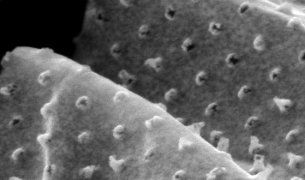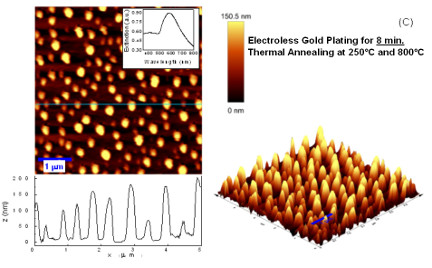Metamaterials
Fabrication

Guided by computational results, Prof. Roper’s group uses both conventional and innovative approaches to fabricate nanoarchitectures. Conventional top-down nano-scale fabrication techniques include optical- and electron-beam lithography (EBL), focussed-ion beam (FIB) milling, vacuum evaporation, and sputtering. Examples of new ‘bottom-up’ approaches include nanosphere lithography, electroless (EL) plating, buffered acid etch, and nanoimprint lithography. These bottom up approaches allow economic methods to fabricate scale-able, stable nanoarchitectures.

Conventional fabrication methods such as FIB or EBL have relied exclusively on thermal evaporation or sputtering to form the metallic NPs. This produces inconsisistencies and defects which reduce performance. The directional nature of this approach also limits particle shapes that can be created. We have modified EL plating to fabricate more uniform, predictable structures with improved plasmonic and transport properties.
Prof. Roper was awarded U.S. Patent 8,097,295, ‘Method of making nanoparticle by electroless plating’ in January 2012. This patent and related research identify a new bottom-up approach to fabricate nanoarchitectures on hard and soft matter substrates.
Performance
The nanoarchitectures include individual nanoparticles as well as random ensembles, assembles on solid substrates, ordered arrays, and nanocomposite materials. These architectures are designed to exhibit extraordinary features such as photocurrent enhancement, sensor sensitivity, or multiphase thermal conductivity.

In particular, Prof. Roper’s group has demonstrated theoretically and experimentally that ordered arrays of metallic nanoparticles (NPs) combine diffractive coupling with localized surface plasmons resulting in enhanced electromagnetic response. For example, our recent theoretical analyses show that for square arrays of spherical Au NP, the electromagnetic field enhancement can be up to 10^7 relative to an isolated NP.
Characterization
Advanced characterization tools used in Roper’s NanoBio Photonics Lab include microscopies (TEM, SEM, AFM, MRI, and cofocal light microscopy), spectroscopies (Raman, SPR, NMR, FTIR, AA, UV, vis, and T-UV), lasers, chromatographies (HPLC, GC) and advanced surface characterization (XPS).
Application
Based on these advances, the NanoBio Photonics Group is developing nanoarchitectures for applications ranging from waveguides, nano-antennae, and optical switches to proteomic/genomic analyzers, surface enhanced Raman spectroscopy (SERS), biosensors, and drug-delivery devices.

